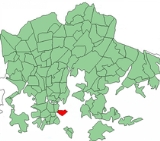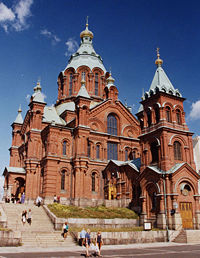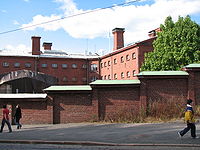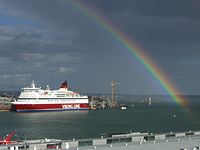
Katajanokka
Encyclopedia
Katajanokka is a neighbourhood of Helsinki
, Finland
, with around 4000 inhabitants in 2005. The district is located adjacent to the immediate downtown area, though in the first major town plan for Helsinki from the mid-18th century, the area fell outside the fortifications planned to encircle the city. Originally, it was a headland
of the Helsinki peninsula
but is now technically an island, as a small canal was dug across the base of the headland in the 19th century.

traveling between Helsinki, Stockholm
, Mariehamn
, Tallinn
and Rostock
. The rest of the district comprises co-operative
apartment buildings and several small parks. The western part of the residential area, known as the "Old Side" of Katajanokka, is an upscale neighborhood and a well-preserved example of early 20th century Art Nouveau
architecture
, though up until the mid-19th century – while the centre of Helsinki was being filled with stone buildings – the area was essentially still a wooden shanty town. The eastern part was for a long time a closed military area containing a naval base and shipyard
, later a commercial shipyard
. It was redeveloped in the 1970s and 1980s into a mainly residential zone, often referred to as the "New Side" of Katajanokka. The new residential area is considered an exceptional example of modern town planning. A major part of the project was the conversion and extension of the old Russian naval barracks to house the Finnish foreign ministry.
The northern shore of Katajanokka still serves as a base for the Finnish coast guard, Helsinki maritime police as well as the Finnish icebreaker
fleet.

 Landmarks of Katajanokka include the Russian Orthodox
Landmarks of Katajanokka include the Russian Orthodox
Cathedral, also known as Uspenski Cathedral
(architect Alexey Gornostaev
, 1868
), the Merikasarmi complex of the Foreign Ministry (architect Carl Ludvig Engel
, 1825
) and the Finnish headquarters of Stora Enso
(architect Alvar Aalto
, 1962
; the most controversial of Aalto's works).
 Another famous building in Katajanokka is the former district prison
Another famous building in Katajanokka is the former district prison
of Southern Finland. The old prison dates back to 1837, and functioned as a prison till 2002. The prison underwent an extensive interior renovation to convert the cells of the prison into hotel rooms, with sets of two or three cells combined to make up the current hotel rooms. The Best Western
Premier Hotel Katajanokka opened in May 2007 with 106 guest rooms. Renovations cost a reported 15 million euro.http://www.hs.fi/kaupunki/artikkeli/Katajanokan+vankilahotelli+avasi+ovensa/1135227425289 As a historic building, strict limits were imposed on the redevelopment due to the strict regime of protection for historically significant buildings that is in effect in Finland. Thus, as a hotel, the exterior of the building has been preserved, as has the central corridor of the old prison and even the old prison wall. A restaurant at the lowest level of the hotel has attempted to keep much of the character of the old prison alive, and is called the "Jailbird Restaurant". However, an actual former prisoner told a Finnish newspaper that the supposed "prison cutlery" is very different from what the prison actually used: for example, prisoners never drank out of tin cups.
 During the development of Katajanokka in the 1970s and 1980s, many old red brick industrial buildings were spared by converting them for public uses, such as a primary school and an indoors sports arena. Recently, there was controversy over the demolition of the former cadet school of the Russian navy, built in the early 20th century. Vacated by the Finnish military in the 1980s, the building survived, with various uses, mainly as a cultural centre. In the late 1990s, the city of Helsinki announced that it was going to demolish the building to build a new apartment building in its place. This caused huge protests, and the demolition was put off for almost a decade, mainly because of opposition from local inhabitants, and the Green League
During the development of Katajanokka in the 1970s and 1980s, many old red brick industrial buildings were spared by converting them for public uses, such as a primary school and an indoors sports arena. Recently, there was controversy over the demolition of the former cadet school of the Russian navy, built in the early 20th century. Vacated by the Finnish military in the 1980s, the building survived, with various uses, mainly as a cultural centre. In the late 1990s, the city of Helsinki announced that it was going to demolish the building to build a new apartment building in its place. This caused huge protests, and the demolition was put off for almost a decade, mainly because of opposition from local inhabitants, and the Green League
party.
The navy school building was finally demolished in autumn 2006. However, additional problems resulted: Contrary to what the city of Helsinki and the architecture
bureau responsible for the new building had thought, there was no solid rock
bottom underneath the old building, but only scattered rocks here and there. Because the original building had stood there since Czarist Russia
, no original construction plans were available, and therefore the new plans had to be redone from scratch.
The local community organisation of Katajanokka is called Katajanokkaseura. The organization publishes an annual regional magazine, Katajanokan kaiku (Finnish for "The Echo of Katajanokka").
, manifested in Alvar Aalto's
Enso-Gutzeit Building, and the red-brick industrial former harbour buildings and prison (now a Best Western hotel).
in Katajanokka:

Helsinki
Helsinki is the capital and largest city in Finland. It is in the region of Uusimaa, located in southern Finland, on the shore of the Gulf of Finland, an arm of the Baltic Sea. The population of the city of Helsinki is , making it by far the most populous municipality in Finland. Helsinki is...
, Finland
Finland
Finland , officially the Republic of Finland, is a Nordic country situated in the Fennoscandian region of Northern Europe. It is bordered by Sweden in the west, Norway in the north and Russia in the east, while Estonia lies to its south across the Gulf of Finland.Around 5.4 million people reside...
, with around 4000 inhabitants in 2005. The district is located adjacent to the immediate downtown area, though in the first major town plan for Helsinki from the mid-18th century, the area fell outside the fortifications planned to encircle the city. Originally, it was a headland
Headlands and bays
Headlands and bays are two related features of the coastal environment.- Geology and geography :Headlands and bays are often found on the same coastline. A bay is surrounded by land on three sides, whereas a headland is surrounded by water on three sides. Headlands are characterized by high,...
of the Helsinki peninsula
Geography of Helsinki
Helsinki has a total area of 686 km2 . 186 km2 of it is land and 500 km2 of the area is covered with water. It is located at .- Subdivisions :...
but is now technically an island, as a small canal was dug across the base of the headland in the 19th century.

Overview
The south side of Katajanokka is dominated by a passenger harbour which is frequented by large cruiseferriesCruiseferry
A cruiseferry is a ship that combines the features of a cruise ship with a Ro-Pax ferry. Many passengers travel with the ships for the cruise experience, staying only a few hours at the destination port or not leaving the ship at all, while others use the ships as means of...
traveling between Helsinki, Stockholm
Stockholm
Stockholm is the capital and the largest city of Sweden and constitutes the most populated urban area in Scandinavia. Stockholm is the most populous city in Sweden, with a population of 851,155 in the municipality , 1.37 million in the urban area , and around 2.1 million in the metropolitan area...
, Mariehamn
Mariehamn
Mariehamn is the capital of Åland, an autonomous territory under Finnish sovereignty. Mariehamn is the seat of the Government and Parliament of Åland, and 40% of the population of Åland live in the city...
, Tallinn
Tallinn
Tallinn is the capital and largest city of Estonia. It occupies an area of with a population of 414,940. It is situated on the northern coast of the country, on the banks of the Gulf of Finland, south of Helsinki, east of Stockholm and west of Saint Petersburg. Tallinn's Old Town is in the list...
and Rostock
Rostock
Rostock -Early history:In the 11th century Polabian Slavs founded a settlement at the Warnow river called Roztoc ; the name Rostock is derived from that designation. The Danish king Valdemar I set the town aflame in 1161.Afterwards the place was settled by German traders...
. The rest of the district comprises co-operative
Housing cooperative
A housing cooperative is a legal entity—usually a corporation—that owns real estate, consisting of one or more residential buildings. Each shareholder in the legal entity is granted the right to occupy one housing unit, sometimes subject to an occupancy agreement, which is similar to a lease. ...
apartment buildings and several small parks. The western part of the residential area, known as the "Old Side" of Katajanokka, is an upscale neighborhood and a well-preserved example of early 20th century Art Nouveau
Art Nouveau
Art Nouveau is an international philosophy and style of art, architecture and applied art—especially the decorative arts—that were most popular during 1890–1910. The name "Art Nouveau" is French for "new art"...
architecture
Architecture
Architecture is both the process and product of planning, designing and construction. Architectural works, in the material form of buildings, are often perceived as cultural and political symbols and as works of art...
, though up until the mid-19th century – while the centre of Helsinki was being filled with stone buildings – the area was essentially still a wooden shanty town. The eastern part was for a long time a closed military area containing a naval base and shipyard
Shipyard
Shipyards and dockyards are places which repair and build ships. These can be yachts, military vessels, cruise liners or other cargo or passenger ships. Dockyards are sometimes more associated with maintenance and basing activities than shipyards, which are sometimes associated more with initial...
, later a commercial shipyard
Shipyard
Shipyards and dockyards are places which repair and build ships. These can be yachts, military vessels, cruise liners or other cargo or passenger ships. Dockyards are sometimes more associated with maintenance and basing activities than shipyards, which are sometimes associated more with initial...
. It was redeveloped in the 1970s and 1980s into a mainly residential zone, often referred to as the "New Side" of Katajanokka. The new residential area is considered an exceptional example of modern town planning. A major part of the project was the conversion and extension of the old Russian naval barracks to house the Finnish foreign ministry.
The northern shore of Katajanokka still serves as a base for the Finnish coast guard, Helsinki maritime police as well as the Finnish icebreaker
Icebreaker
An icebreaker is a special-purpose ship or boat designed to move and navigate through ice-covered waters. Although the term usually refers to ice-breaking ships, it may also refer to smaller vessels .For a ship to be considered an icebreaker, it requires three traits most...
fleet.


Russian Orthodox Church
The Russian Orthodox Church or, alternatively, the Moscow Patriarchate The ROC is often said to be the largest of the Eastern Orthodox churches in the world; including all the autocephalous churches under its umbrella, its adherents number over 150 million worldwide—about half of the 300 million...
Cathedral, also known as Uspenski Cathedral
Uspenski Cathedral
Uspenski Cathedral is an Eastern Orthodox cathedral in Helsinki, Finland, dedicated to the Dormition of the Theotokos . Its name comes from the Old Church Slavonic word uspenie, which denotes the Dormition...
(architect Alexey Gornostaev
Alexey Gornostaev
Alexey Maksimovich Gornostaev was a Russian architect, notable as a pioneer in Russian Revival, the builder of Valaam Monastery hermitages, Trinity-Sergius Convent in Saint Petersburg and Uspenski Cathedral in Helsinki...
, 1868
1868 in architecture
The year 1868 in architecture involved some significant events.-Buildings:* Alfred Waterhouse wins the competition for the design of Manchester Town Hall in England.* The Gyeongbokgung of Korea is completed.-Awards:...
), the Merikasarmi complex of the Foreign Ministry (architect Carl Ludvig Engel
Carl Ludvig Engel
Carl Ludvig Engel, or Johann Carl Ludwig Engel , was a German architect known for his neoclassical style. He had a great impact on the architecture of Finland in the first part of the 19th century....
, 1825
1825 in architecture
The year 1825 in architecture involved some significant events.-Buildings:* The front and rear porticoes of The White House are added to the building.* Tuskulėnai Manor in Vilnius by Karol Podczaszyński completed-Births:...
) and the Finnish headquarters of Stora Enso
Stora Enso
Stora Enso Oyj is a Finnish pulp and paper manufacturer, formed by the merger of Swedish mining and forestry products company Stora and Finnish forestry products company Enso-Gutzeit Oy in 1998. It is headquartered in Helsinki, and it has approximately 29,000 employees...
(architect Alvar Aalto
Alvar Aalto
Hugo Alvar Henrik Aalto was a Finnish architect and designer. His work includes architecture, furniture, textiles and glassware...
, 1962
1962 in architecture
The year 1962 in architecture involved some significant events.-Buildings and structures:*May 25 - Coventry Cathedral in England, designed by Basil Spence, is consecrated.*July 1 - The Minolta Tower in Niagara Falls is opened....
; the most controversial of Aalto's works).

Prison
A prison is a place in which people are physically confined and, usually, deprived of a range of personal freedoms. Imprisonment or incarceration is a legal penalty that may be imposed by the state for the commission of a crime...
of Southern Finland. The old prison dates back to 1837, and functioned as a prison till 2002. The prison underwent an extensive interior renovation to convert the cells of the prison into hotel rooms, with sets of two or three cells combined to make up the current hotel rooms. The Best Western
Best Western
Best Western International, Inc. is the third largest hotel chain, with over 4,195 hotels in nearly 80 countries. The chain, with its corporate headquarters in Phoenix, Arizona, operates more than 2,000 hotels in North America alone. Best Western has a marketing program involving placement of free...
Premier Hotel Katajanokka opened in May 2007 with 106 guest rooms. Renovations cost a reported 15 million euro.http://www.hs.fi/kaupunki/artikkeli/Katajanokan+vankilahotelli+avasi+ovensa/1135227425289 As a historic building, strict limits were imposed on the redevelopment due to the strict regime of protection for historically significant buildings that is in effect in Finland. Thus, as a hotel, the exterior of the building has been preserved, as has the central corridor of the old prison and even the old prison wall. A restaurant at the lowest level of the hotel has attempted to keep much of the character of the old prison alive, and is called the "Jailbird Restaurant". However, an actual former prisoner told a Finnish newspaper that the supposed "prison cutlery" is very different from what the prison actually used: for example, prisoners never drank out of tin cups.

Green League
The Green League is a centrist green liberal political party in Finland. It has ten seats in the Finnish Parliament and two in the European Parliament. The current chairperson is Ville Niinistö....
party.
The navy school building was finally demolished in autumn 2006. However, additional problems resulted: Contrary to what the city of Helsinki and the architecture
Architecture
Architecture is both the process and product of planning, designing and construction. Architectural works, in the material form of buildings, are often perceived as cultural and political symbols and as works of art...
bureau responsible for the new building had thought, there was no solid rock
Rock (geology)
In geology, rock or stone is a naturally occurring solid aggregate of minerals and/or mineraloids.The Earth's outer solid layer, the lithosphere, is made of rock. In general rocks are of three types, namely, igneous, sedimentary, and metamorphic...
bottom underneath the old building, but only scattered rocks here and there. Because the original building had stood there since Czarist Russia
Russia
Russia or , officially known as both Russia and the Russian Federation , is a country in northern Eurasia. It is a federal semi-presidential republic, comprising 83 federal subjects...
, no original construction plans were available, and therefore the new plans had to be redone from scratch.
The local community organisation of Katajanokka is called Katajanokkaseura. The organization publishes an annual regional magazine, Katajanokan kaiku (Finnish for "The Echo of Katajanokka").
Architecture
Katajanokka is principally known for its fine examples of Jugendstil architecture. Other prominent styles apparent on the island are modernismModernism
Modernism, in its broadest definition, is modern thought, character, or practice. More specifically, the term describes the modernist movement, its set of cultural tendencies and array of associated cultural movements, originally arising from wide-scale and far-reaching changes to Western society...
, manifested in Alvar Aalto's
Alvar Aalto
Hugo Alvar Henrik Aalto was a Finnish architect and designer. His work includes architecture, furniture, textiles and glassware...
Enso-Gutzeit Building, and the red-brick industrial former harbour buildings and prison (now a Best Western hotel).
Politics
Results of the Finnish parliamentary election, 2011Finnish parliamentary election, 2011
An election to the Eduskunta was held on 17 April 2011 after the termination of the previous parliamentary term. Advance voting, which included voting by Finnish expatriates, was held between 6 and 12 April with a turnout of 31.2%....
in Katajanokka:
- National Coalition Party 35.0%
- Green LeagueGreen LeagueThe Green League is a centrist green liberal political party in Finland. It has ten seats in the Finnish Parliament and two in the European Parliament. The current chairperson is Ville Niinistö....
20.1% - Social Democratic PartySocial Democratic Party of FinlandThe Social Democratic Party of Finland is one of the three major political parties in Finland, along with the Centre Party and the National Coalition Party. Jutta Urpilainen is the current SDP leader. The party has been in the Finnish government cabinet for long periods and has set many...
13.0% - Swedish People's Party 8.8%
- Left AllianceLeft Alliance (Finland)The Left Alliance is a left-wing political party in Finland. It was founded on the basis of the Finnish People's Democratic League and the Communist Party of Finland in 1990....
8.8% - True FinnsTrue FinnsTrue Finns or The Finns is a populist and nationalist political party in Finland, founded in 1995 following the dissolution of the Finnish Rural Party. The head of the movement is Timo Soini. In the 2011 Finnish parliamentary election, The party won 19.1% of votes, becoming the third largest party...
8.0% - Centre PartyCentre Party (Finland)The Centre Party is a centrist and Nordic agrarian political party in Finland. It is one of the four largest political parties in the country, along with the Social Democratic Party , the National Coalition Party and the True Finns , and currently has 35 seats in the Finnish Parliament...
3.8% - Christian DemocratsChristian Democrats (Finland)The Christian Democrats is a Christian democratic political party in Finland. Formerly known as the Finnish Christian League , the Christian Democrats have six seats in the Finnish Parliament and one in the European Parliament.The party was founded in 1958, chiefly from the Christian faction of...
1.2%
Literature

- Griffiths, Gareth (1997). The Polemical Aalto. The Enso-Gutzeit Building (1959-62), Datutop 19, Tampere. ISBN 951-722-789-2 (an account of the saga of Aalto's controversial building on Katajanokka.)
- Jaatinen, Carina & Lindh, Tommi & Lunkka, Hannu (1998). Helsingin kantakaupungin rakennuskulttuuri. Katajanokan kaupunginosan inventointi. Helsingin kaupunginmuseo. ISBN 951-718-174-4. (An examination of the architectural history of Katajanokka.)
- Kervanto Nevanlinna, Anja (2002). Kadonneen kaupungin jäljillä. Teollisuusyhteiskunnan muutoksia Helsingin historiallisessa ytimessä. ("Tracing the lost city. Industrial transformations in the historical heart of Helsinki. With summary and captions in English.") Suomalaisen Kirjallisuuden Seura. ISBN 951-746-307-3. (Takes a critical look at the 20th Century transformation of the Eteläsatama seafront in Helsinki, with an emphasis on Katajanokka.)
- Moorhouse, Jonathan & Carapetian, Michael & Ahtola-Moorhouse, Leena (1987). Helsinki Jugendstil 1895—1915. Otava Verlag. ISBN 951-1-08382-1. (Describes the architecture of Katajanokka, p. 198—228. Also available in Finnish as ISBN 951-1-09018-6.)
- Narinkka (1989). Helsinki City Museum. (A detailed exploration of the history of Katajanokka before the 20th Century. Written by Viljo Erkamo and Kerttuli Wessman. Includes an English summary, titled "Katajanokka's humble past. Old drawings and paintings: a documentary record of city ethnography".) ISSN 035-9106.
- Ollila, Kaija & Toppari, Kirsti (1975): Puhvelista Punatulkkuun. Helsingin vanhoja kortteleita. Sanoma Osakeyhtiö. ISBN 951-9134-69-7. (Information and historical anecdotes on the city blocks and buildings of Helsinki. Covers the entire "Old Side" of Katajanokka, among other districts.)
Articles in architectural journals
- Arkkitehti 1931. Frequently cited debate from the early 1930s regarding the state and the future of Katajanokka.
- Helander, Vilhelm & Pakkala, Pekka & Sundman, Mikael: Katajanokan kärjen asemakaavaluonnos. ("The draft plan for the 'tip of Katajanokka'") Arkkitehti 2/1975, p. 32 pp. Early description of the winning plan for the "New Side" by the architects involved.
- Pakkala, Pekka: Katajanokan vanhan asuntoalueen asemakaava ("The plan for the old residential area of Katajanokka"). Arkkitehti 4/1981, p. 42 pp. Detailed article on the preservation of the "Old Side".
External links
- Katajanokka home site
- Buildings of the "Old Side" of Katajanokka — Pictures of all the buildings of the "Old Side", with information on the architects and dates of erection of each building
- Etymology and pronunciation of Skatudden (in Swedish) — An article on the Swedish name of Katajanokka, published by the Research Institute for the Languages of Finland

